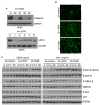Lipoprotein Receptor-related Protein 6 Signaling is Necessary for Vasculogenic Differentiation of Human Dental Pulp Stem Cells
- PMID: 28778505
- PMCID: PMC5657009
- DOI: 10.1016/j.joen.2017.06.006
Lipoprotein Receptor-related Protein 6 Signaling is Necessary for Vasculogenic Differentiation of Human Dental Pulp Stem Cells
Abstract
The aim of this study was to evaluate the effects of Wnt signaling through lipoprotein receptor-related protein 6 (LRP6) and Frizzled6 on the endothelial differentiation of dental pulp stem cells (DPSCs). DPSCs were stably transduced with enhanced green fluorescent protein (EGFP)-tagged lentiviral vectors (short hairpin RNA-LRP6, short hairpin RNA-Frizzled6, or empty vector controls). We evaluated the effects of LRP6 and Frizzled6 on expression of endothelial markers and on capillary tube formation mediated by DPSCs induced with recombinant human Wnt1 (rhWnt1) and/or recombinant human vascular endothelial growth factor165 (rhVEGF165). In vivo, tooth slices/scaffolds were seeded with LRP6-silenced, Frizzled6-silenced, or vector control DPSC cells and transplanted into immunodeficient mice. The density of blood vessels generated by DPSCs differentiated into vascular endothelial cells was analyzed by immunohistochemistry for EGFP. The rhWnt1 and rhVEGF165 induced expression of active β-catenin in control DPSCs and in Frizzled6-silenced DPSCs, but not in LRP6-silenced DPSCs. Furthermore, VEGF and interleukin-8 were downregulated in LRP6-silenced DPSCs, but not in control DPSCs or in Frizzled6-silenced DPSCs (P < .05). Likewise, rhWnt1 and rhVEGF165 induced expression of the endothelial marker VEGF receptor-2 in control DPSCs and in Frizzled6-silenced DPSCs, but not in LRP6-silenced DPSCs. These data correlated with a trend for lower density of capillary sprouts generated by LRP6-silenced DPSCs when compared with control DPSCs in Matrigel. In vivo, tooth slice/scaffolds seeded with DPSC-short hairpinRNA-LRP6 cells showed lower density of human blood vessels (ie, EGFP-positive blood vessels), when compared with tooth slice/scaffolds seeded with vector control cells (P < .05). Collectively, these data demonstrated that LRP6 signaling is necessary for the vasculogenic differentiation of human DPSCs.
Keywords: Angiogenesis; Wnt; cell fate; regenerative endodontics; tissue engineering.
Copyright © 2017 American Association of Endodontists. Published by Elsevier Inc. All rights reserved.
Conflict of interest statement
The authors declare no potential conflicts of interest with respect to the authorship and/or publication of this article.
Figures




Similar articles
-
VE-Cadherin and Anastomosis of Blood Vessels Formed by Dental Stem Cells.J Dent Res. 2020 Apr;99(4):437-445. doi: 10.1177/0022034520902458. Epub 2020 Feb 6. J Dent Res. 2020. PMID: 32028818 Free PMC article.
-
Role of Heparan Sulfate in Vasculogenesis of Dental Pulp Stem Cells.J Dent Res. 2023 Feb;102(2):207-216. doi: 10.1177/00220345221130682. Epub 2022 Oct 24. J Dent Res. 2023. PMID: 36281071 Free PMC article.
-
VEGFR1 primes a unique cohort of dental pulp stem cells for vasculogenic differentiation.Eur Cell Mater. 2021 Mar 16;41:332-344. doi: 10.22203/eCM.v041a21. Eur Cell Mater. 2021. PMID: 33724439 Free PMC article.
-
Wnt/β-Catenin Signaling Determines the Vasculogenic Fate of Postnatal Mesenchymal Stem Cells.Stem Cells. 2016 Jun;34(6):1576-87. doi: 10.1002/stem.2334. Epub 2016 Mar 11. Stem Cells. 2016. PMID: 26866635 Free PMC article.
-
Dental pulp stem cells overexpressing stromal-derived factor-1α and vascular endothelial growth factor in dental pulp regeneration.Clin Oral Investig. 2019 May;23(5):2497-2509. doi: 10.1007/s00784-018-2699-0. Epub 2018 Oct 12. Clin Oral Investig. 2019. PMID: 30315421
Cited by
-
Comparative Evaluation of the Cytotoxic and Angiogenic Effects of Minocycline and Clindamycin: An In Vitro Study.J Endod. 2019 Jul;45(7):882-889. doi: 10.1016/j.joen.2019.04.007. Epub 2019 May 24. J Endod. 2019. PMID: 31133343 Free PMC article.
-
Prevascularization techniques for dental pulp regeneration: potential cell sources, intercellular communication and construction strategies.Front Bioeng Biotechnol. 2023 May 18;11:1186030. doi: 10.3389/fbioe.2023.1186030. eCollection 2023. Front Bioeng Biotechnol. 2023. PMID: 37274160 Free PMC article. Review.
-
Dentin sialoprotein promotes endothelial differentiation of dental pulp stem cells through DSPaa34-50-endoglin-AKT1 axis.J Biol Chem. 2025 Apr;301(4):108380. doi: 10.1016/j.jbc.2025.108380. Epub 2025 Mar 4. J Biol Chem. 2025. PMID: 40049415 Free PMC article.
-
Neuroprotection mediated by the Wnt/Frizzled signaling pathway in early brain injury induced by subarachnoid hemorrhage.Neural Regen Res. 2019 Jun;14(6):1013-1024. doi: 10.4103/1673-5374.250620. Neural Regen Res. 2019. PMID: 30762013 Free PMC article.
-
LRP6/filamentous-actin signaling facilitates osteogenic commitment in mechanically induced periodontal ligament stem cells.Cell Mol Biol Lett. 2023 Jan 24;28(1):7. doi: 10.1186/s11658-023-00420-5. Cell Mol Biol Lett. 2023. PMID: 36694134 Free PMC article.
References
-
- Nakashima M, Akamine A. The application of tissue engineering to regeneration of pulp and dentin in endodontics. J Endod. 2005;31:711–8. - PubMed
-
- Nör JE. Tooth regeneration in operative dentistry. Oper Dent. 2006;31:633–2. - PubMed
-
- Brey EM, Uriel S, Greisler HP, McIntire LV. Therapeutic neovascularization: contributions from bioengineering. Tissue Eng. 2005;11:567–84. - PubMed
-
- Gronthos S, Brahim J, Li W, et al. Stem cell properties of human dental pulp stem cells. J Dent Res. 2002;81:531–5. - PubMed
MeSH terms
Substances
Grants and funding
LinkOut - more resources
Full Text Sources
Other Literature Sources
Medical

